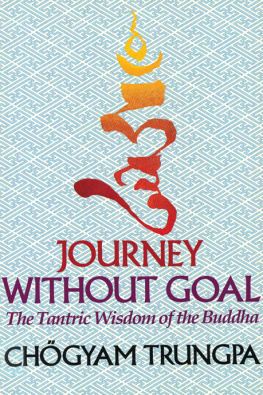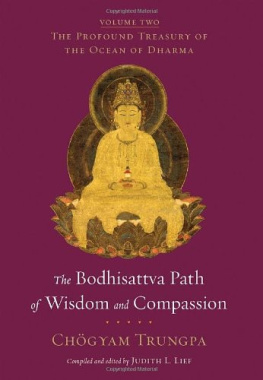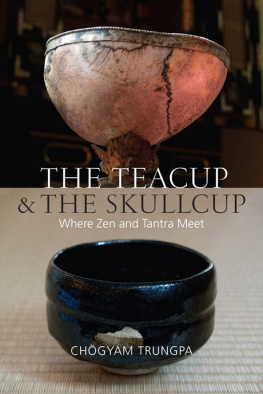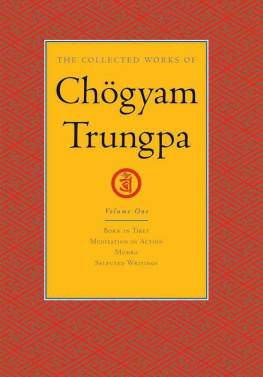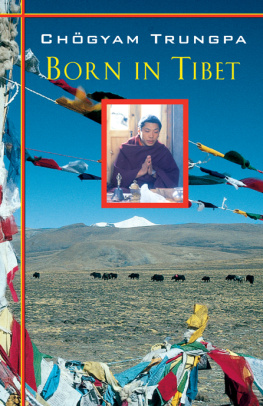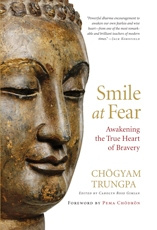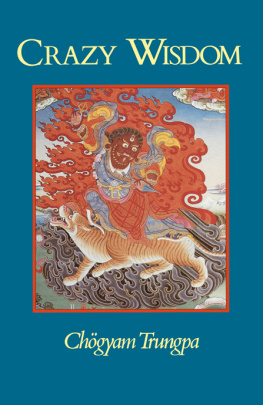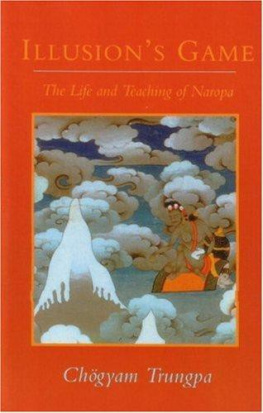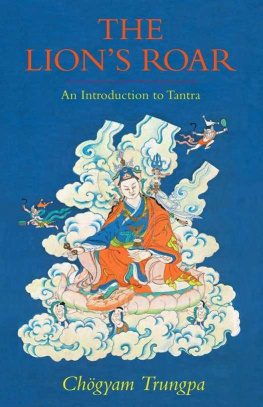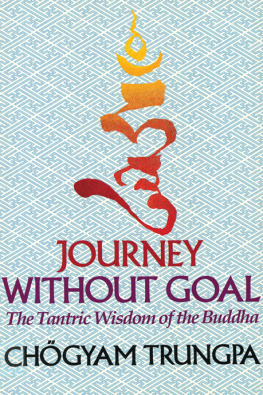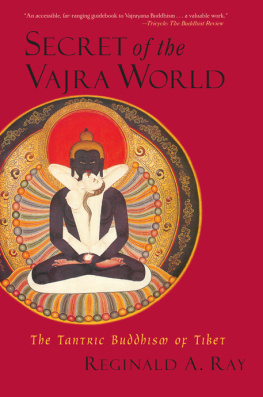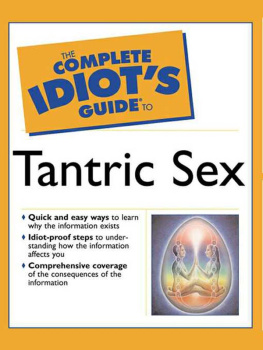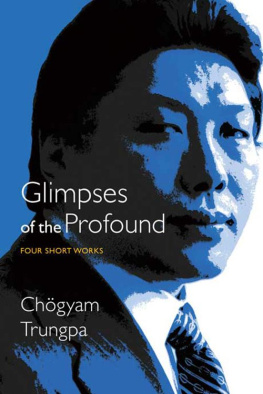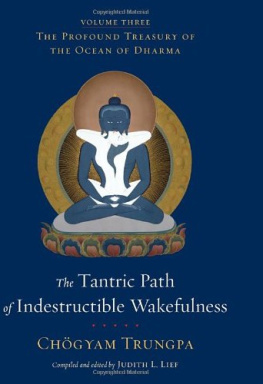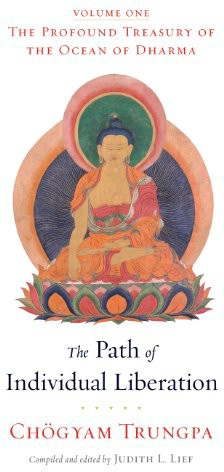
JOURNEY WITHOUT GOAL
The Tantric Wisdom of the Buddha
Chgyam Trungpa

SHAMBHALA BOSTON & LONDON 2010
SHAMBHALA PUBLICATIONS, INC.
Horticultural Hall
300 Massachusetts Avenue
Boston, Massachusetts 02115
www.shambhala.com
1981 by Chgyam Trungpa
All rights reserved. No part of this book may be reproduced in any form or by any means, electronic or mechanical, including photocopying, recording, or by any information storage and retrieval system, without permission in writing from the publisher.
The Library of Congress catalogues the previous edition of this book as follows:
Trungpa, Chgyam, 19391987
Journey without goal.
Based on a series of lectures delivered . . . in the Buddhist Studies
Department of Naropa Institute, Summer 1974T.p. verso.
Reprint. Originally published: Boulder, Colo.: Prajn Press, 1981.
Includes index.
Tantric BuddhismDoctrinesAddresses, essays, lectures.
Spiritual life (Tantric Buddhism)Addresses, essays, lectures.
I. Title.
BQ8918.7.T78 1985 294.3925 85-8175
eISBN 978-0-8348-2137-8
ISBN 978-1-57062-757-6
ISBN 978-0-87773-334-8
ISBN 978-0-394-74194-9
Lord Marpas Praise to the Gurus is excerpted from The Life of Marpa the Translator, translated by the Nland Translation Committee under the direction of Chgyam Trungpa, 1982 by Chgyam Trungpa, published by Shambhala Publications, Inc.
CONTENTS
ILLUSTRATIONS
Padma Trime, Jamgn Kongtrl of Sechen (1901?1960). The root guru of Chgyam Trungpa and an incarnation of Lodr Thaye, Jamgn Kongtrl I.
Lodr Thaye, Jamgn Kongtrl I (18131899). Often referred to as Jamgn Kongtrl the Great, Lodr Thaye was a leader of the Rime movement (see Chapter 10). This painting is from the lineage thangkas at Rumtek Monastery in Sikkim, India. Photo used by the gracious permission of His Holiness the Sixteenth Gyalwa Karmapa, Rangjung Rikpe Dorje.
The Mandala of Kalacakra. A two-dimensional representation of the mandalas of body, speech, and mind of the Kalacakra Tantra.
Jetsn Milarepa (10401123). The chief disciple of Marpa, Milarepa is renowned for his songs of devotion and realization. This statue was a shrine object of Gampopa, Milarepas chief disciple. Photo credit: George Holmes and Blair Hansen.
Cakrasamvara and Vajravarahi. Two of the principal yidams, or personal deities, of the Kagy school of Tibetan Buddhism, used in tantric visualization practice. This statue was a shrine object of Naropa, Marpas guru. Photo credit: George Holmes and Blair Hansen.
Vajra and Ghanta (bell). Photo credit: George Holmes.
Vajradhara. The dharmakaya buddha. A tantric manifestation of the Buddha, Vajradhara is depicted as dark blue. Painting by Sherapalden Beru. Photo credit: George Holmes and Blair Hansen.
Evam. The personal seal of Chgyam Trungpa and the Trungpa tulkus (see Chapter 14). Design: Molly K. Nudell.
Rangjung Dorje, Karmapa III (12841339). A great vajrayana scholar and teacher, famous for bringing together the teachings of ati yoga with anuttara tantra. This painting is from the lineage thangkas at Rumtek Monastery in Sikkim, India. Photo used by the gracious permission of His Holiness the Sixteenth Gyalwa Karmapa, Rangjung Rikpe Dorje.
ACKNOWLEDGMENTS
Journey without Goal is based on a series of fifteen lectures presented by Vajracarya the Venerable Chgyam Trungpa, Rinpoche, at Naropa Institute during the summer of 1974. Under his guidance, Mrs. Judith Lief, then the Editor-in-Chief at Vajradhatu, began editing the lectures for publication in 1975. Working with the author and other members of the editorial department, she completed the major part of the manuscript before leaving to become the Dean of Naropa Institute in 1980.
The preparation of the final draft of the manuscript has been a collaborative effort by members of the editorial department: Mrs. Sarah Levy, Mrs. Barbara Blouin, Mrs. Helen Berliner, and myself. We have tried to maintain Mrs. Liefs approach to the material, which always respected the language of the original and showed an acute sensitivity to meaning and tone.
We are deeply indebted to the Vajracarya for the original presentation of this material and for allowing us the opportunity to deepen our own understanding through working with him on the manuscript.
We would like to thank the Nland Translation Committee for the translation from the Tibetan of the two poems that appear in the book. The first, Intensifying Devotion in Ones Heart is by Jamgn Kongtrl the Great, whose contributions to the Practice Lineage of Tibetan Buddhism are discussed in Chapter Ten, Abhisheka. The second, Lord Marpas Praise to the Gurus, is by Marpa the Translator, the first Tibetan holder of the Kagy lineage. It is taken from a larger work in progress, The Life of Marpa, to be published by Shambhala Publications. Particular thanks go to Miss Christine Keyser of the translation committee, who completed the initial draft of the translation of Jamgn Kongtrls poem; and to Mr. Larry Mermelstein, the executive director of the committee, for editorial contributions to the entire manuscript.
We would also like to express our thanks to the Vajra Regent sel Tendzin and to Dr. Reginald Ray, Chairman of the Buddhist Studies Department at Naropa Institute, for their careful reading of the final typescript. As well, we would like to acknowledge the efforts of the many volunteerstypists, transcribers, and otherswho worked on this book. Finally, we would like to thank the publisher, Mr. Samuel Bercholz, and the staff of Praj Press for their support of this book.
The reader may note that the language in this book is often poetic and evocative. These qualities have been treated as essential rather than incidental aspects of the original lectures, since they express most vividly the awake and brilliant experience of the vajra world.
The vajrayana wisdom that is presented here is powerful and authentic. We hope that this book will lead to a greater appreciation and understanding of tantric Buddhism, and we share in the authors wish that this book may benefit sentient beings and bring them to the path of dharma.
Carolyn Rose Gimian
Vajradhatu Editorial Department
Introduction
T he teachings of the Buddha are a treasury of wisdom that has been passed down from teacher to student for over 2,500 years. Many styles of teaching have developed, but all of the schools of Buddhism present the means to realize the awakened state of mind, and all of them emulate the example of the Buddha, the Awakened One. This is a very important point to realize, particularly in the context of this book, which presents tantra, or the vajrayana teachings of Buddhism. Many people in America have heard about tantra as the sudden paththe quick way to enlightenment. Or they may have heard that tantra is a form of free expression or sexual liberation or some kind of full-blown emotionalism. But it is important to realize that tantra is not separate from the rest of the Buddhist path. Exotic ideas about tantra are not just misconceptions; they could be quite destructive. It is both dangerous and fruitless to attempt to practice tantra without first establishing a firm ground in the basic Buddhist teachings.
The Buddhist path is traditionally divided into three major yanas or vehicles: the hinayana, the mahayana, and the vajrayana. Hinayana literally means the small or lesser vehicle, but it would be more accurate to call it the narrow way. The hinayana is small or narrow in the sense that the strict discipline of meditation narrows down, or tames, the speed and confusion of mind, allowing the mind to rest in its own place. The hinayana is also called the immediate yana because hinayana practice allows simple and direct experience of our own minds and of the world. We begin to realize that whatever we experiencewhether good or bad, positive or negativeis workable, tamable.
Next page
